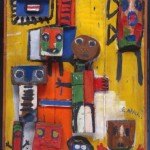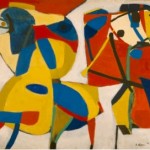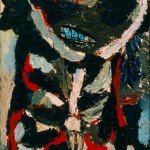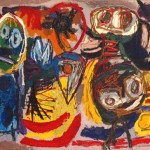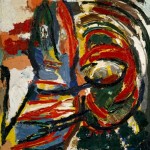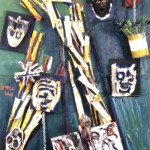Karel Appel
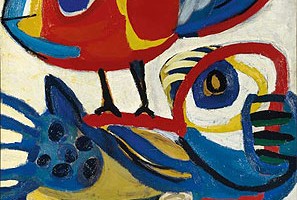
Christiaan Karel Appel was born on April 25, 1921 at his parents house in a working-class district in Amsterdam, Netherlands. On the ground floor, his father, Jan Appel, had a barber shop. His mother, Johanna Chevalier, was a descendant of French Huguenots. Karel Appel had three brothers and as a child, he was nicknamed Kik.
From 1940 to 1943 he studied art at the Rijksakademie van Beeldende Kunsten in Amsterdam. In 1946 Appel held his firls solo exhibition at Het Beerenhuis in Groningen, the Netherlands. He also participated in the Jonge Schilders exhibition at the Stedelijk Museum of Amsterdam the same year.
Click here to continue reading this biography
Appel was influenced by the works of Pablo Picasso and Henri Matisse and later by the artist Jean Dubuffet. He was an associate of the Nederlandse Experimentele Groep and established the celebrated COBRA movement in 1948 with Corneille, Constant, Christian Dotremont, Joseph Noiret and Asger Jorn. In 1949 Appel completed a large mural for the cafeteria of the city hall in Amsterdam. The mural caused such a controversy that it was hidden from public for the next ten years.
As a founding member of CoBrA, the European art movement of the late 1940s to early 1950s, Appel rebuked the formal style of earlier Dutch abstractionist’s de Stijl. Characterized by unrestrained brush work, unabashed color, and severe lines, Appel’s paintings exhibited a primal, childlike characteristic. During his Cobra period Karel Appel moved to Paris in 1950, where he lived until moving to New York in 1957. From 1952 on, he began to experience growing international attention, due in no small part with the backing of the renowned French art critic and promoter Michel Tapie.
Karel Appel died at the age of 85 on May 3, 2006 in his home in Zürich, Switzerland. Being a child of the war, he was once quoted as saying “If I paint like a barbarian, it’s because we live in a barbarous age”. Still his work has always expressed a boundless love for life, full of exuberance, passion and fervor, yet wrapped in a kind embrace.
- photograph of Karel Appel
- Little Moon Men – 1946
- Questioning Children – 1949
- Hip, Hip, Hoorah! – 1949
- Ontmoeting (Encounter) – 1951
- Horse and Flute Player – 1951
- Wild Boy – 1954
- People, Birds and Sun – 1954
- Amorous Dance – 1955
- The Crying Crocodile Tries to Catch the Sun – 1956
- Lucebert Dierentemmer (Animal tamer) – 1959
- Market Square



